List of polyhedral stellations
In three-dimensional space, a stellation extends facets of a polyhedron to form a new figure. Usually, this is achieved by extending faces or edges and planes of a polyhedron, until they generate new vertices that bound a newly formed figure.
This article mainly lists various stellations belonging to uniform polyhedra, such as those of the regular Platonic solids and the semiregular Archimidean solids. It also lists stellations featuring unbounded vertices.
Background
Star polytopes
Experimentation with star polygons and star polyhedra since the fourteenth century AD led the way to formal theories for stellating polyhedra:
- 14th c. AD: Thomas Bradwardine was the first to detail studies of star polygons by extending the sides of polygons.[2]
- 15th – 16th c.: Charles de Bovelles became the first to study star polyhedra.[3]
- 1509: Luca Pacioli publishes Divina proportione, featuring woodcut illustrations by Leonardo da Vinci of various polyhedra, including "elevated" polyhedra that have been augmented by attaching pyramids to faces, as showcased with the stellated octahedron.[4][a]
- 1568: Wenzel Jamnitzer publishes Perspectiva Corporum Regularium, with ink engravings on paper of various polyhedra, including figures closely resembling the great stellated dodecahedron[6] and the great dodecahedron,[7] both stellations of the regular dodecahedron.
It was in 1619 that the first mathematical description of a stellation was given, by Johannes Kepler in his landmark book, Harmonice Mundi: the process of extending the edges (or faces) of a figure until they meet again to obtain a new figure. Using this method, Kepler was able to discover the small stellated dodecahedron and the great stellated dodecahedron. In 1809, Louis Poinsot rediscovered Kepler's figures by putting together star pentagons around each vertex. He also assembled convex polygons around star vertices, leading him to discover two more regular stars, the great icosahedron and great dodecahedron. Three years later, Augustin-Louis Cauchy proved, using concepts of symmetry, that these four stellations are the only regular star-polyhedra, eventually termed the Kepler–Poinsot polyhedra.
Stellation process
Coxeter et al. (1938) details, for the first time, stellations of the regular icosahedron with specific rules proposed by J. C. P. Miller.[8] Generalizing these (Miller's rules) for stellating any uniform polyhedron yields the following:[9]
- The faces must lie in face-planes, i.e., the bounding planes of the regular solid.
- All parts composing the faces must be the same in each plane, although they may be quite disconnected.
- The parts included in any one plane must be symmetric about corresponding point groups, without or with reflection. This secures polyhedral symmetry for the whole solid.
- All parts included in planes must be "accessible" in the completed solid (i.e. they must be on the "outside").
- Cases where the parts can be divided into two sets, each giving a solid with as much symmetry as the whole figure, are excluded from consideration; combination of enantiomorphous pairs having no common part (which actually occurs in just one case) are included.
These rules are ideal for stellating smaller uniform solids, such as the regular polyhedra; however, when assessing stellations of other larger uniform polyhedra, this method can quickly become overwhelming. (For example, there are a total of 358,833,072 stellations to the rhombic triacontahedron using this set of rules.)[10] To address this, Pawley (1973) proposed a set of rules that restrict the number of stellations to a more manageable set of fully supported stellations that are radially convex,[11][12] such that an outward ray from the center of the original polyhedron (in any direction) crosses the stellation surface only once[9] (that is to say, all visible parts of a face are seen from the same side).
H. S. M. Coxeter was the first to describe the stellation process as the reciprocal action to faceting, in his 1948 first edition of Regular Polytopes.[13] He further specifies the construction of a star polyhedron as a stellation of its core (with congruent face-planes), or by faceting its case — the former requires the addition of solid pieces that generate new vertices, while the latter involves the removal of solid pieces, without forming any new vertices.[14][b]
Lists
Lists for polyhedral stellations contain non-convex polyhedra; some of the most notable examples include:[c]
- the regular Kepler-Poinsot polyhedra (W20, W21, W22, and W41/C7)
- the regular compound polyhedra (W19, W2/C3, W24/C47, W25/C22, UC9) as well as
- compound dual polyhedra made of either Platonic solids or Kepler-Poinsot polyhedra (W19, W47, W61, W43, and the great icosahedron and great stellated dodecahedron compound)
Examples of stellations that topologically do not fit into standard definitions of uniform polyhedra are listed further down (i.e. stellations of hemipolyhedra).[16]
| Image | Name | Stellation core | Ref. | Notes |
|---|---|---|---|---|
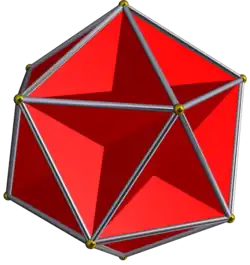 |
Great dodecahedron | Regular dodecahedron | W21 |
*, ¶
|
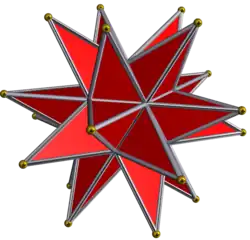 |
Great stellated dodecahedron | W22
| ||
 |
Small stellated dodecahedron | W20
|
*
| |
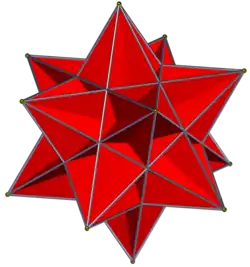 |
Great icosahedron | Regular icosahedron | W41,C7
| |
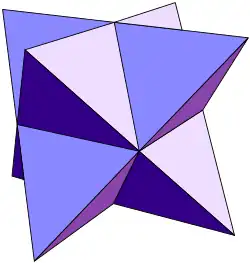 |
Stellated octahedron | Regular octahedron | W19 |
†, ‡, ¶
|
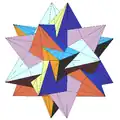 |
Compound of five tetrahedra | Regular icosahedron | W24,C47 |
†
|
 |
Compound of five octahedra | W2,C3
| ||
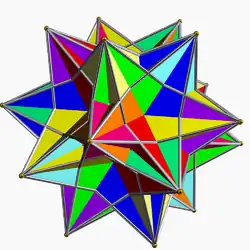 |
Compound of ten tetrahedra | W25,C22
| ||
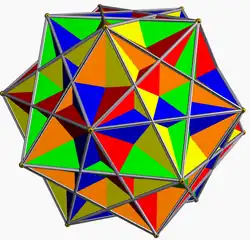 |
Compound of five cubes | Rhombic triacontahedron | ||
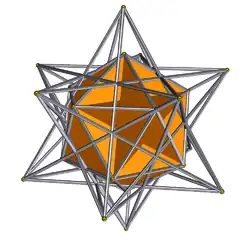 |
Compound of great dodecahedron and small stellated dodecahedron | ‡
| ||
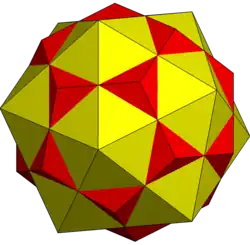 |
Compound of dodecahedron and icosahedron | Icosidodecahedron | W47
| |
 |
Compound of great icosahedron and great stellated dodecahedron | W61
| ||
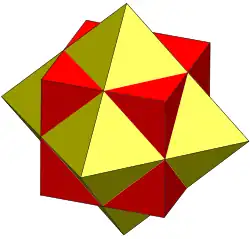 |
Compound of cube and octahedron | Cuboctahedron | W43
| |
 |
Small triambic icosahedron | Regular icosahedron | W1,C2 |
¶
|
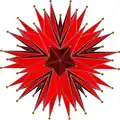 |
Final stellation of the icosahedron | W13,C8
| ||
 |
First stellation of the rhombic dodecahedron | Rhombic dodecahedron |
- KEY
* Kepler-Poinsot polyhedron
† Regular compound polyhedron
‡ Platonic or Kepler-Poinsot dual polyhedra
¶ First and/or outermost stellation
"Ref." (references) such as indexes found in Coxeter et al. (1999) using the Crennells' illustration notation (C), and Wenninger (1971) (W).
"Stellation core" describes a stellated regular (Platonic), semi-regular (Archimedean), or dual to a semi-regular (Catalan) figure.
Stellations of the octahedron
The stella octangula (or stellated octahedron), is the only stellation of the regular octahedron.[21] This stellation is made of self-dual tetrahedra, as the simplest regular polyhedral compound:[22]
| Figure | Stellation |
|---|---|
Stellated octahedron
stella octangula | |
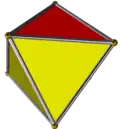 |
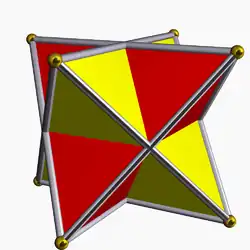 |
Different from the larger, regular self-dual polyhedral enantiomorphisms (such as in the compound of five cubes), the tetrahedron is the only Platonic solid to generate a stellation (and regular polyhedron compound) from a single intersecting copy of itself.[e] Like the cube, the regular tetrahedron does not generate stellations when extending its faces, since all are adjacent (this yields only one possible convex hull).[21]
Stellations of the icosahedron

Coxeter et al. (1938) details stellations of the regular icosahedron with (aformentioned) rules proposed by J. C. P. Miller. The following table lists all such stellations per the Crennells' indexing, as found in Coxeter et al. (1999). In this list,[f] the regular icosahedron (or snub octahedron) stellation core is indexed as "1" (press "show" to open the table):
| Stellations of the regular icosahedron | ||||||
|---|---|---|---|---|---|---|
| Crennell | Cells | Faces | Figure | Face diagram | ||
| 1 | A | 0 | 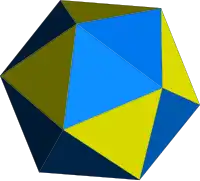
|
 | ||
| 2 | B | 1 | 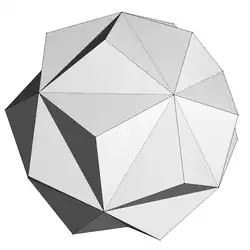
|
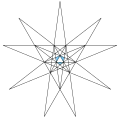 | ||
| 3 | C | 2 | 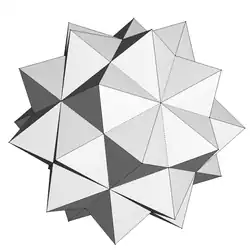
|
 | ||
| 4 | D | 3 4 | 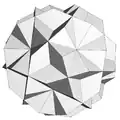
|
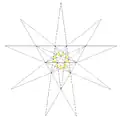 | ||
| 5 | E | 5 6 7 | 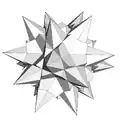
|
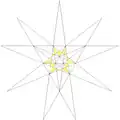 | ||
| 6 | F | 8 9 10 | 
|
 | ||
| 7 | G | 11 12 | 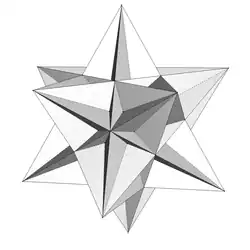
|
 | ||
| 8 | H | 13 | 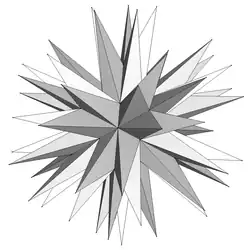
|
 | ||
| 9 | e1 | 3' 5 | 
|
 | ||
| 10 | f1 | 5' 6' 9 10 | 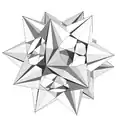
|
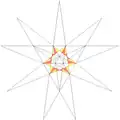 | ||
| 11 | g1 | 10' 12 | 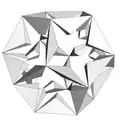
|
 | ||
| 12 | e1f1 | 3' 6' 9 10 | 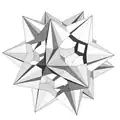 |
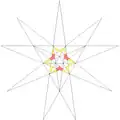 | ||
| 13 | e1f1g1 | 3' 6' 9 12 | 
|
 | ||
| 14 | f1g1 | 5' 6' 9 12 | 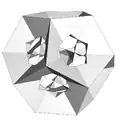 |
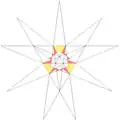 | ||
| 15 | e2 | 4' 6 7 | 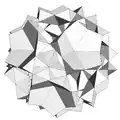 |
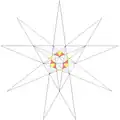 | ||
| 16 | f2 | 7' 8 | 
|
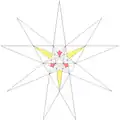 | ||
| 17 | g2 | 8' 9'11 | 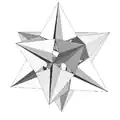 |
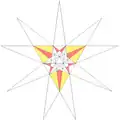 | ||
| 18 | e2f2 | 4' 6 8 |  |
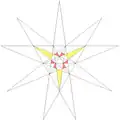 | ||
| 19 | e2f2g2 | 4' 6 9' 11 | 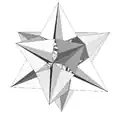 |
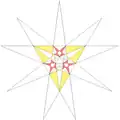 | ||
| 20 | f2g2 | 7' 9' 11 | 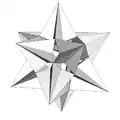
|
 | ||
| 21 | De1 | 4 5 | 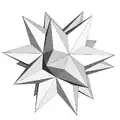
|
 | ||
| 22 | Ef1 | 7 9 10 | 
|
 | ||
| 23 | Fg1 | 8 9 12 | 
|
 | ||
| 24 | De1f1 | 4 6' 9 10 | 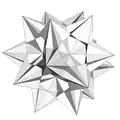 |
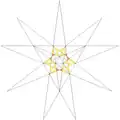 | ||
| 25 | De1f1g1 | 4 6' 9 12 | 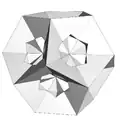 |
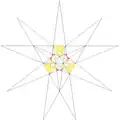 | ||
| 26 | Ef1g1 | 7 9 12 | 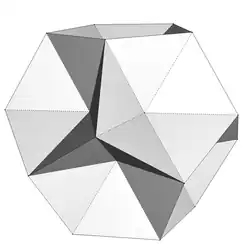
|
 | ||
| 27 | De2 | 3 6 7 | 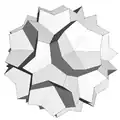
|
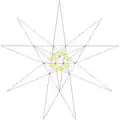 | ||
| 28 | Ef2 | 5 6 8 | 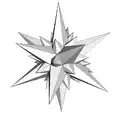
|
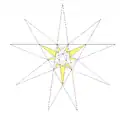 | ||
| 29 | Fg2 | 10 11 | 
|
 | ||
| 30 | De2f2 | 3 6 8 | 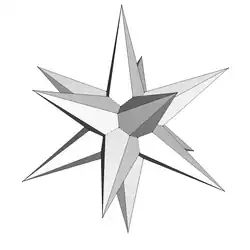
|
 | ||
| 31 | De2f2g2 | 3 6 9' 11 | 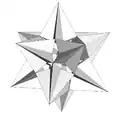 |
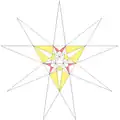 | ||
| 32 | Ef2g2 | 5 6 9' 11 | 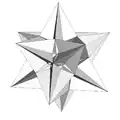 |
 | ||
| 33 | f1 | 5' 6' 9 10 | 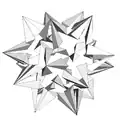
|
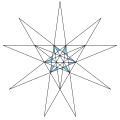 | ||
| 34 | e1f1 | 3' 5 6' 9 10 | 
|
 | ||
| 35 | De1f1 | 4 5 6' 9 10 |  |
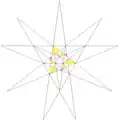 | ||
| 36 | f1g1 | 5' 6' 9 10' 12 | 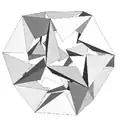 |
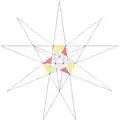 | ||
| 37 | e1f1g1 | 3' 5 6' 9 10' 12 | 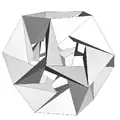
|
 | ||
| 38 | De1f1g1 | 4 5 6' 9 10' 12 | 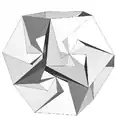 |
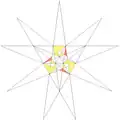 | ||
| 39 | f1g2 | 5' 6' 8' 9' 10 11 |  |
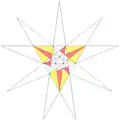 | ||
| 40 | e1f1g2 | 3' 5 6' 8' 9' 10 11 |  |
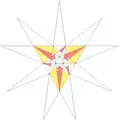 | ||
| 41 | De1f1g2 | 4 5 6' 8' 9' 10 11 |  |
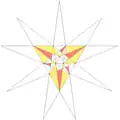 | ||
| 42 | f1f2g2 | 5' 6' 7' 9' 10 11 |  |
 | ||
| 43 | e1f1f2g2 | 3' 5 6' 7' 9' 10 11 | 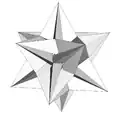 |
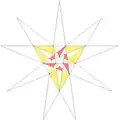 | ||
| 44 | De1f1f2g2 | 4 5 6' 7' 9' 10 11 |  |
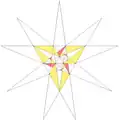 | ||
| 45 | e2f1 | 4' 5' 6 7 9 10 | 
|
 | ||
| 46 | De2f1 | 3 5' 6 7 9 10 |  |
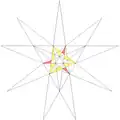 | ||
| 47 | Ef1 | 5 6 7 9 10 | 
|
 | ||
| 48 | e2f1g1 | 4' 5' 6 7 9 10' 12 | 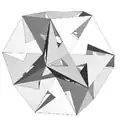 |
 | ||
| 49 | De2f1g1 | 3 5' 6 7 9 10' 12 | 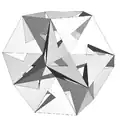 |
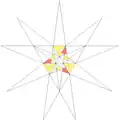 | ||
| 50 | Ef1g1 | 5 6 7 9 10' 12 | 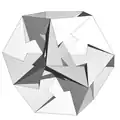 |
 | ||
| 51 | e2f1f2 | 4' 5' 6 8 9 10 | 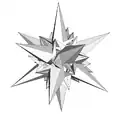
|
 | ||
| 52 | De2f1f2 | 3 5' 6 8 9 10 |  |
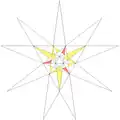 | ||
| 53 | Ef1f2 | 5 6 8 9 10 |  |
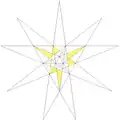 | ||
| 54 | e2f1f2g1 | 4' 5' 6 8 9 10' 12 |  |
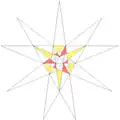 | ||
| 55 | De2f1f2g1 | 3 5' 6 8 9 10' 12 |  |
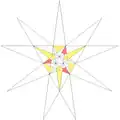 | ||
| 56 | Ef1f2g1 | 5 6 8 9 10' 12 |  |
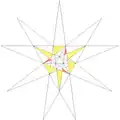 | ||
| 57 | e2f1f2g2 | 4' 5' 6 9' 10 11 |  |
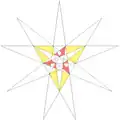 | ||
| 58 | De2f1f2g2 | 3 5' 6 9' 10 11 | 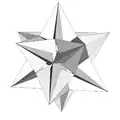 |
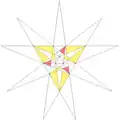 | ||
| 59 | Ef1f2g2 | 5 6 9' 10 11 | 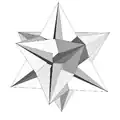 |
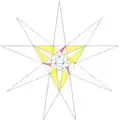 | ||
Wenninger (1971) includes a subset of these as formal stellations, primarily based on illustrative methods of construction of stellated polyhedral models (and extending to stellations of the icosidodecahedron).[23] While only one stellation of the icosahedron is a Kepler-Poinsot polyhedron, all stellations of the dodecahedron are Kepler-Poinsot polyhedra (the remaining).
Hemipolychrons
In Wenninger (1983), a unique family of stellations with unbounded vertices are identified.[16] These originate from orthogonal edges of faces that pass through centers of their corresponding dual hemipolyhedra. The following is a list of these stellations; specifically, of non-convex, uniform hemipolyhedra (with coincidental figures in parentheses).
| Image | Name | Stellation core |
|---|---|---|
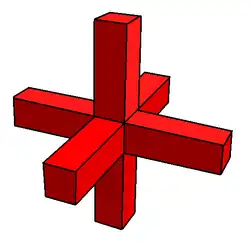 |
Tetrahemihexacron | Tetrahemihexahedron |
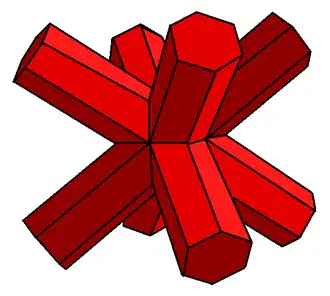 |
Hexahemioctacron (octahemioctacron) |
Octahemioctahedron |
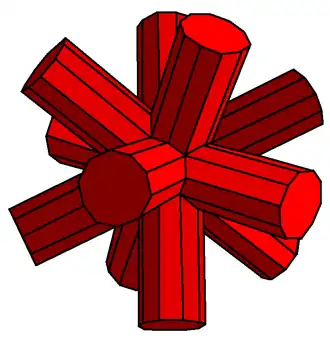 |
Small dodecahemidodecacron (small icosihemidodecacron) |
Small icosihemidodecahedron |
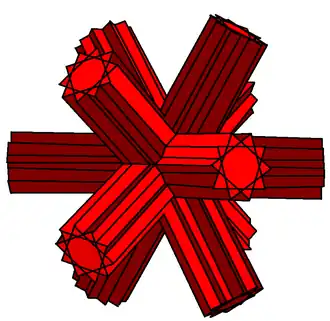 |
Great icosihemidodecacron (great dodecahemidodecacron) |
Great dodecahemidodecahedron |
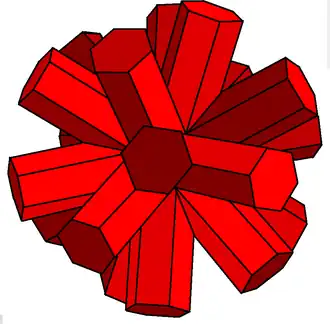 |
Small dodecahemicosacron (great dodecahemicosacron) |
Great dodecahemicosahedron |
This family of stellations does not strictly fulfill the definition of a polyhedron that is bound by vertices, and Wenninger notes that at the limit their facets can be interpreted as forming unbounded elongated pyramids, or equivalently, prisms (indistinguishably).[24] Of these, only the tetrahemihexahedron would produce a stellation without another coincidental figure, the tetrahemihexacron.
Notes
- ^ In this same work, da Vinci illustrates a concaved triakis icosahedron, which shares its outer shell with the great stellated dodecahedron.[5]
- ^ The core of a star polyhedron or compound is the largest convex solid that can be drawn inside them, while their case is the smallest convex solid that contains them.[15]
- ^ Using index notation from Coxeter et al. (1999) (C), the Crennells' third edition of The Fifty-Nine Icosahedra, and Magnus Wenninger's notation as found in Wenninger (1971) (W), where applicable.
- ^ Forms a honeycomb with copies of itself.[20]
- ^ Regular compound polyhedra larger than the stellated octahedron are made of larger sets of regular polyhedra with chiral symmetry.
- ^ "Cell" corresponds to the internal spaces formed by extending face-planes of the regular icosahedron (du Val notation). In a symmetric figure such as the regular icosahedron, these cell types form groups or sets of congruent cells, unique to each stellation — a set of cells forming a closed layer around its core forms a shell, which can be made of multiple types (e.g., e comprises e1 and e2).
Sources
Works cited
- ^ Brückner (1900), p. 260.
- ^ Coxeter (1969), p. 37.
- ^ Chasles (1875), pp. 480, 481.
- ^ Pacioli (1509), pls. XIX, XX.
- ^ Pacioli (1509), pls. XXV, XXVI.
- ^ Jamnitzer (1568), eng. F.IIII.
- ^ Jamnitzer (1568), eng. C.V.
- ^ Coxeter et al. (1938), pp. 7, 8.
- ^ a b Webb (2001), Miller's rules.
- ^ Messer (1995), p. 26.
- ^ Wenninger (1983), pp. 36, 153.
- ^ Messer (1995), p. 27.
- ^ Coxeter (1948), p. 95.
- ^ Coxeter (1948), p. 99.
- ^ Coxeter (1948), p. 98.
- ^ a b Wenninger (1983), pp. 101–119.
- ^ Pawley (1975), p. 225.
- ^ Weisstein.
- ^ Holden (1971), p. 134.
- ^ Holden (1971), p. 165.
- ^ a b Coxeter (1973), p. 96.
- ^ Coxeter (1973), pp. 48, 49.
- ^ Wenninger (1971), pp. 34–36, 41–65.
- ^ Wenninger (1983), pp. 101, 103, 104.
References
- Brückner, Max (1900). Vielecke und Vielflache: Theorie und Geschichte [Polygons and Polyhedra: Theory and History] (in German). Leipzig: B.G. Treubner. pp. 1–268. ISBN 978-1418165901.
{{cite book}}: ISBN / Date incompatibility (help) - Chasles, Michel (1875). Aperçu historique sur l'origine et le développement des méthodes en géométrie particulièrement de celles qui se rapportent à la géométrie moderne, suivi d'un mémoire de géométrie sur deux principes généraux de la science, la dualité et l'homographie [Historical overview of the origin and development of methods in geometry, particularly those relating to modern geometry, followed by a geometry dissertation on two general principles of science, duality and homography.] (in French) (2nd ed.). Paris (École Polytechnique): Gauthiers-Villars. pp. 1–851 – via Gallica.
- Coxeter, H. S. M. (1969). Introduction to Geometry (2nd ed.). New York: Wiley. pp. 1–486. ISBN 0471182834.
- Coxeter, H. S. M. (1948). Regular Polytopes (1st ed.). London: Methuen & Co. pp. 1–321.
- Third edition: Coxeter, H. S. M. (1973). Regular Polytopes. New York: Dover. ISBN 0-486-61480-8.
- Coxeter, H. S. M.; du Val, P.; Flather, P.; Petrie, J. F. (1938). "The Fifty-Nine Icosahedra". University of Toronto Studies (Mathematical Series) (6). University of Toronto Press. Plates. I–XX; pp. 1–26.
- Second edition: Coxeter, H. S. M.; et al. (1982). The Fifty-Nine Icosahedra. New York: Springer-Verlag. ISBN 978-0-387-90770-3.
- Third edition: Coxeter, H. S. M.; et al. (1999). The Fifty-Nine Icosahedra. Illustrations by Kate and David Crennell. Tarquin. pp. 1–72. ISBN 978-1899618323.
- Holden, Alan (1971). Shapes, space, and symmetry. New York: Columbia University Press. pp. 1–200. ISBN 9780231035491.
- Jamnitzer, Wenzel (1568). Perspectiva Corporum Regularium. Engravings by Jost Amman (A.I–I.III) from drawings by Jamnitzer. Nuremberg: Christoph Heussler. pp. 1–4.
- Messer, Peter W. (1995). "Stellations of the rhombic triacontahedron and beyond" (PDF). Structural Topology (21). Structural Topology Research Group (University of Montreal): 25–46. ISSN 0226-9171.
- Pacioli, Luca (1509). Divina proportione. Woodcut illustrations by Leonardo da Vinci (I–LXI). Venice: Paganino Paganini.
- Manuscript: Pacioli, Luca (December 14, 1498). Divina proportione. Colored woodcut illustrations by Leonardo da Vinci (I–LXI). Milan: Biblioteca Ambrosiana.
- Original manuscript reprint: Pacioli, Luca (1956). De Divina Proportione. Fontes Ambrosiani. Vol. 31. Colored woodcut illustrations by Leonardo da Vinci (I–LXI). Milan: Mediobanca. pp. i–xxix, 1–247.
- Pawley, G. S. (1975). "The 227 triacontahedra". Geometriae Dedicata. 4 (2–4): 221–232. doi:10.1007/BF00148756. S2CID 123506315.
- Pawley, G. S. (1973). "Stellated triacontahedra" (Document). Unpublished manuscript.
- Webb, Robert (2001). "Stella Polyhedral Glossary". Stella.
- Weisstein, Eric W. "Great Dodecahedron-Small Stellated Dodecahedron Compound". MathWorld. Wolfram Research.
- Wenninger, Magnus (1971). Polyhedron Models. Cambridge University Press. pp. 1–208. ISBN 0521069173.
- Wenninger, Magnus (1983). Dual Models. Cambridge University Press. pp. 1–156. doi:10.1017/CBO9780511569371. ISBN 0521098599. MR 0730208.
External links
- Stellation and Facetting - a Brief History from Guy's Polyhedral Pages (Guy Inchbald) for a brief chronology regarding stellation
- Stella Polyhedral Glossary from Stella (Robert Webb) for a list of relevant terminology regarding stellations
- Enumeration of Stellations lists counts of stellations for Platonic, Archimedean and Catalan solids, as well as select prisms and antiprisms
- 59 Stellations of the Icosahedron from Virtual Polyhedra (George W. Hart)
- Icosahedron Stellations from Mathworld (Eric W. Weisstein) - contains an image of all stellations based on the icosahedron (per Coxeter)